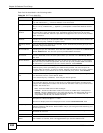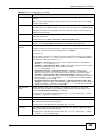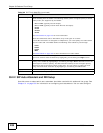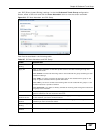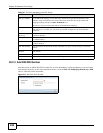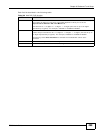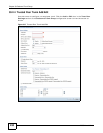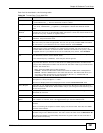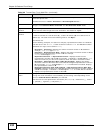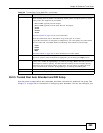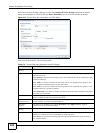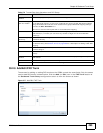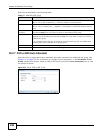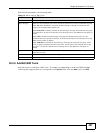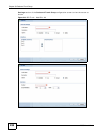
Chapter 30 Outbound Trunk Group
ISG50 User’s Guide
492
CallerID Setting Configure this section to change the format of identification you want to send when you
make VoIP phone calls.
The default format is “From: “Extension”<Extension@Server IP>”.
CallerID Viewer
This field displays the caller ID format shown to the callees depending on the setting you
configure in the CallerID Name & Number and The Extension Prefix fields.
Representative
Number
Specify the representative number shown as source caller ID to the callees when you
make external calls through this trunk connection. The default is “zyxel”.
CallerID Name &
Number
Select the caller ID display format you want to use when you make calls.
A caller ID consists of a call ID name (A), a caller ID number (B) and a SIP server IP
address (C). The caller ID has the following format: “A”<B@C>.
The choices are:
(In the following examples, we assume a company representative number is 12345678,
their SIP server IP is 10.1.1.1, a caller extension number is 1111 and DDI/DID number
12345555 can map to the extension 1111.)
• Extension + Extension: Displays the caller’s extension number in A and B. For
example, “1111”<1111@10.1.1.1>.
• Extension + Representative Num.: Displays the caller’s extension number in A and
the SIP trunk’s representative number in B. For example,
“1111”<12345678@10.1.1.1>.
• Representative Num. + Representative Num.: Displays the SIP trunk’s
representative number in A and B. For example, “12345678”<12345678@10.1.1.1>.
Select this format if you don’t want callees to know the caller’s extension number.
• Extension + Representative Num (DDI/DID mapped): Displays the caller’s
extension number in A and the SIP trunk’s DDI/DID mapped representative number in
B. For example, “1111”<12345555@10.1.1.1>. If no DDI/DID is matched, displays
the representative number in B.
• Representative Num (DDI/DID mapped) + Representative Num (DDI/DID
mapped): Displays the SIP trunk’s DDI/DID mapped representative number in both A
and B. For example, “12345555”<12345555@10.1.1.1>. If no DDI/DID is matched,
displays the representative number in A and B.
The Extension
Prefix
Specify whether to add a prefix number in the callerID name when you make calls
through this trunk connection. The availability of this setting varies depending on the
format of CallerID Name & Number you selected.
This field can be 0-20 alphanumeric characters (A-Z, a-z, 0-9), underscores (_), colons
(:), periods (.), hyphens (-) and pluses (+)
Table 169 Trusted Peer Trunk Add/Edit (continued)
LABEL DESCRIPTION



